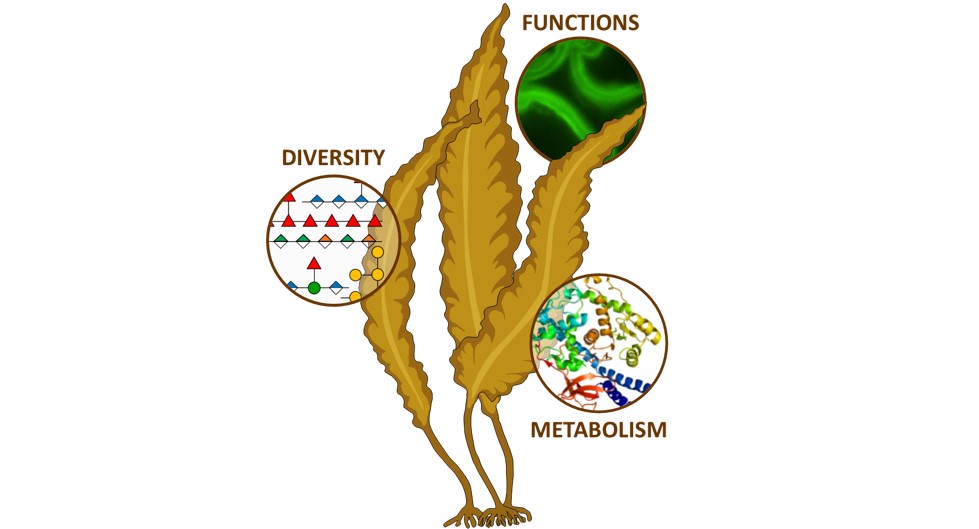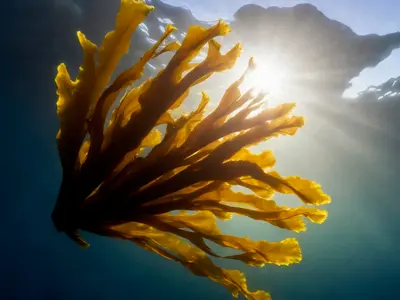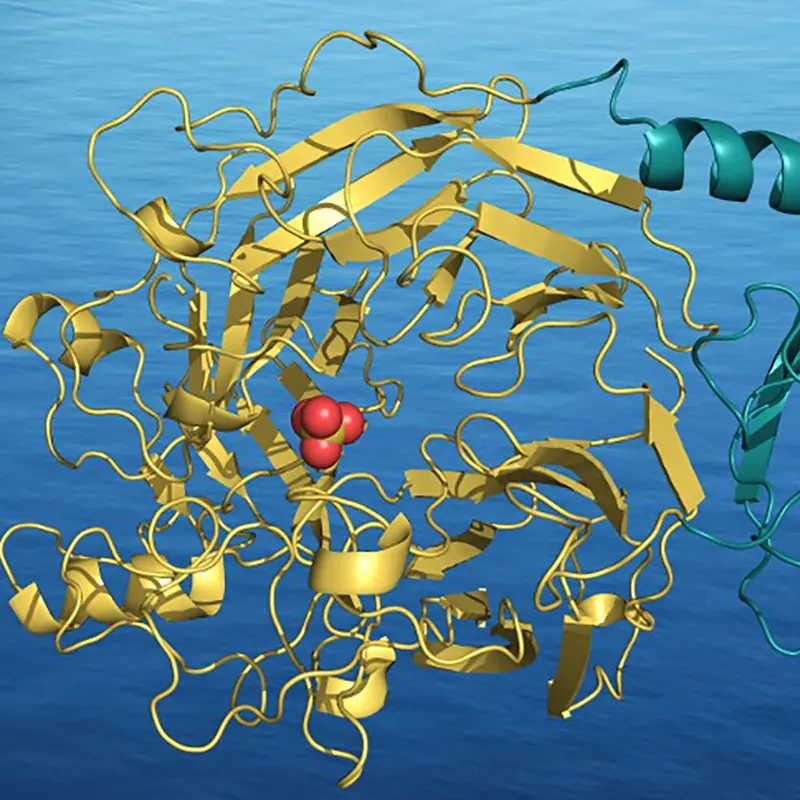
Team BAG - Brown Algal Glycans
The BAG team aims to understand the structure, synthesis and functions from brown algal glycans. These glycans, or polysaccharides, are of physiological importance and constitute a key resource for various uses (food, hydrocolloids and nutraceuticals). To unravel their metabolic pathways, we use genomic and biochemical approaches, along with functional studies.
Brown algae represent a rich but underutilised biomass. They evolve in dynamic ecosystems, and to thrive in such habitats they exhibit large plasticity in terms of metabolic responses, including in their constitutive glycans. The main glycans of brown algae are components of their extracellular matrices (ECMs) or cell walls, with essentially alginates and fucans/fucoidans, and storage polysaccharides with laminarins. ECM polysaccharides affect algal development in various ways, including cell development, communication between cells and defense responses. Recently fucans/fucoidans were recognised as significant actors in carbon sequestration. Besides, their derived oligosaccharides have strong potential as nutraceuticals.
Cultivation and uses of brown algae are anticipated to expand in the near future, yet their basic primary metabolism is scarcely known, and this is particularly true for the biosynthesis and remodelling of their polysaccharides. Only recently have algal genomic resources allowed us to annotate and predict candidate genes but no functional validation has been performed yet. Additionally, the fine-tuning of glycan structures and their location in developing tissues are largely unknown.
Research projects of the BAG team
Our research interests are focused on brown algal polysaccharides, with three specific objectives:

Objective 1 “Diversity”: Investigating in great-detail the chemical diversity and dynamics of brown algal polysaccharides.
Objective 2 “Metabolism”: Determining the complete biosynthetic, remodelling and degrading pathways of brown algal glycans, with the specific understanding of the 3D-structure/function and evolutionary relationship of major enzymes.
Objective 3 “Functions”: Exploring the roles of glycans in algal physiological responses. Correlations between glycan structures and their physiological roles are also investigated.
Methods
- Bioinformatic analyses of transcriptomic/genomic data
- Extraction, fractionation and analytical chemistry of polysaccharides
- Production of recombinant proteins in prokaryotic and eukaryotic systems
- Biochemical and structural analyses of enzymes
- Monoclonal antibody generation and cell culture
- Immunohistochemistry and imaging
SeaProbes
As a service, we maintain the cell lines producing the Brown Algal Monoclonal (BAM) antibodies against sulfated fucans/fucoidans (BAM1-4) and alginates (BAM6-11).
Our monoclonal antibodies are available for use through SeaProbes.

CristalO
Our activity is also tightly linked to the CristalO facility, where we offer strong expertise in structural and functional studies of soluble proteins.

Contact(s)
- Cécile HervéCNRS Research Director
Projects
People

Publications
Exploration of the extracellular matrix of the red alga Chondrus crispus reveals unprecedented insights into carrageenan structures
David Ropartz, Adrien Lissarrague, Murielle Jam, Diane Jouanneau, Bastien Annic, et al.. Exploration of the extracellular matrix of the red alga Chondrus crispus reveals unprecedented insights into carrageenan structures. Carbohydrate Polymers, 2025, 348, pp.122737. ⟨10.1016/j.carbpol.2024.122737⟩. ⟨hal-04734206⟩
Identification and Characterization of a New Thermophilic κ‑Carrageenan Sulfatase
Nanna Rhein-Knudsen, Diego S Reyes-Weiss, Leesa J Klau, Alexandra Jeudy, Thomas Roret, et al.. Identification and Characterization of a New Thermophilic κ‑Carrageenan Sulfatase. Journal of Agricultural and Food Chemistry, 2025, 73, pp.2044 - 2055. ⟨10.1021/acs.jafc.4c09751⟩. ⟨hal-04923334⟩
Constrained Catalytic Itinerary of a Retaining 3,6-Anhydro-D-Galactosidase, a Key Enzyme in Red Algal Cell Wall Degradation
Michael Wallace, Irene Cuxart, Thomas Roret, Laura Guée, Aleksandra Debowski, et al.. Constrained Catalytic Itinerary of a Retaining 3,6-Anhydro-D-Galactosidase, a Key Enzyme in Red Algal Cell Wall Degradation. Angewandte Chemie International Edition, In press, Online ahead of print. ⟨10.1002/anie.202411171⟩. ⟨hal-04700900⟩
Candidate genes involved in biosynthesis and degradation of the main extracellular matrix polysaccharides of brown algae and their probable evolutionary history
Lisa Mazéas, Ahlem Bouguerba-Collin, J. Mark Cock, France Denoeud, Olivier Godfroy, et al.. Candidate genes involved in biosynthesis and degradation of the main extracellular matrix polysaccharides of brown algae and their probable evolutionary history. BMC Genomics, 2024, 25 (1), pp.950. ⟨10.1186/s12864-024-10811-3⟩. ⟨hal-04734202⟩
Unveiling the role of novel carbohydrate‐binding modules in laminarin interaction of multimodular proteins from marine Bacteroidota during phytoplankton blooms
Marie-Katherin Zühlke, Elizabeth Ficko-Blean, Daniel Bartosik, Nicolas Terrapon, Alexandra Jeudy, et al.. Unveiling the role of novel carbohydrate‐binding modules in laminarin interaction of multimodular proteins from marine Bacteroidota during phytoplankton blooms. Environmental Microbiology, 2024, 26 (5), pp.e16624. ⟨10.1111/1462-2920.16624⟩. ⟨hal-04579759⟩
Evolutionary genomics of the emergence of brown algae as key components of coastal ecosystems
France Denoeud, Olivier Godfroy, Corinne Cruaud, Svenja Heesch, Zofia Nehr, et al.. Evolutionary genomics of the emergence of brown algae as key components of coastal ecosystems. Cell, 2024, 187 (24), pp.6943-6965. ⟨10.1016/j.cell.2024.10.049⟩. ⟨hal-04794231⟩






